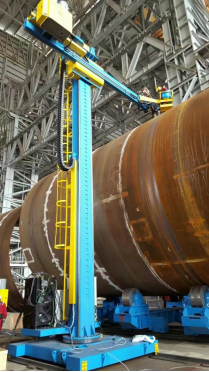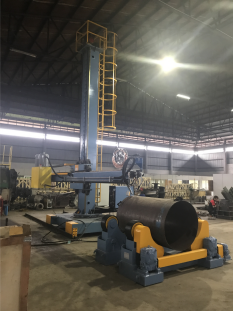The Critical Role of Welding in Wind Tower Manufacturing
Wind energy has emerged as a leading renewable power source, driving demand for robust and reliable wind tower structures. These massive cylindrical components require exceptionally strong welds to withstand decades of environmental stress. Traditional welding methods often fall short in meeting the stringent quality and efficiency demands of modern wind tower production.
This is where advanced welding manipulators with rotating columns prove indispensable. These sophisticated systems combine precision automation with heavy-duty performance to deliver consistent, high-quality welds on large-diameter cylindrical structures. For manufacturers seeking to optimize their wind tower production lines, investing in the right welding manipulator technology can significantly enhance productivity while reducing operational costs.
Why Rotating Column Welding Manipulators Excel in Wind Tower Applications
Superior Handling of Large Cylindrical Structures
The unique design of welding manipulators with rotating columns makes them ideally suited for wind tower fabrication. Unlike standard welding equipment, these systems feature a 360-degree rotating column that maintains optimal torch positioning throughout the welding process. This capability is particularly valuable when working with the curved surfaces of wind tower sections, where maintaining consistent weld quality across the entire circumference is challenging.
The rotating column design allows operators to perform continuous welding operations without needing to frequently reposition the workpiece. This not only improves weld consistency but also dramatically reduces production time compared to conventional welding methods. When evaluating welding manipulator vs welding positioner options for wind tower production, the manipulator’s ability to combine torch movement with column rotation provides clear advantages for large-scale cylindrical welding applications.
Enhanced Automation for Improved Productivity
Modern wind tower welding manipulators[1] incorporate advanced automation features that transform production efficiency. Programmable logic controllers (PLCs) enable precise control over welding parameters, while motorized traverse units ensure accurate torch positioning throughout the welding process. This level of automation minimizes human intervention, reducing the potential for errors while increasing overall output.
Automated welding manipulators[2] particularly shine in high-volume production environments where repeatability is crucial. By storing optimized welding programs for different tower sections, manufacturers can achieve consistent results across multiple production runs. The combination of rotating column technology with automated controls creates a welding solution that meets the wind energy industry’s demanding quality standards while maximizing throughput.

Key Considerations When Selecting a Wind Tower Welding Manipulator
Assessing Load Capacity and Structural Rigidity
Wind tower fabrication involves working with exceptionally thick steel plates, often exceeding 100mm in thickness. This demands welding manipulators with robust construction and high load-bearing capacity. Heavy-duty models with reinforced rotating columns and rigid boom arms provide the stability needed for demanding submerged arc welding (SAW) applications common in wind tower production.
When evaluating potential systems, manufacturers should pay close attention to the manipulator’s structural design and material composition. Units constructed from high-grade steel with precision-machined components will better maintain alignment under heavy loads, ensuring consistent weld quality throughout extended production runs. The ability to handle substantial payloads while maintaining positioning accuracy is a critical factor in wind tower welding applications.
Optimizing for Submerged Arc Welding Processes
Most wind tower manufacturers rely heavily on submerged arc welding due to its superior penetration and deposition rates. When selecting a welding manipulator for cylindrical tanks and wind tower sections, it’s essential to choose a system specifically optimized for SAW processes. Key features to look for include compatibility with heavy wire feeders, sufficient amperage capacity, and proper flux recovery systems.
The rotating column design should accommodate the unique requirements of SAW, including the need for consistent wire feed angles and proper flux coverage throughout the welding operation. Some advanced models offer integrated flux handling systems and specialized torch configurations that further enhance SAW performance on large cylindrical workpieces.

The Future of Wind Tower Fabrication Technology
As the wind energy sector continues to expand, welding technology must evolve to meet growing production demands. The latest generation of welding manipulators with rotating columns represents a significant leap forward in fabrication efficiency. These systems not only address current manufacturing challenges but also provide the flexibility to adapt to future design innovations in wind tower construction.
Manufacturers investing in this technology today position themselves to remain competitive in an industry where weld quality and production efficiency directly impact project viability. By leveraging the capabilities of advanced welding manipulators , wind tower producers can achieve new levels of precision and productivity while maintaining the structural integrity required for these critical renewable energy components.
The transition to automated welding solutions is no longer optional for serious players in the wind tower fabrication space. As projects scale up and quality requirements become more stringent, welding manipulators with rotating columns will increasingly become the standard for producing the massive cylindrical sections that form the backbone of modern wind energy infrastructure.
